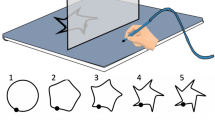Abstract
It has been proposed that mirror drawing is difficult because of the conflict between visual and proprioceptive signals from the arm. However, even without proprioception, there should be difficulties in planning movements to visual targets observed in a mirror, as the mirror-reversed spatial information must be translated into appropriate hand actions. Mirror drawing tasks suggest these planning conflicts are likely to be most obvious at corners, when encountering sharp changes in direction. We have therefore tested the speed of mirror drawing in a chronically deafferented man and in a control group of normal subjects, and hypothesized that increases in template complexity (number of corners) would result in reduced drawing speeds in all subjects. Indeed, all subjects, including the deafferented man, showed movement durations that increased linearly as the complexity of the drawings increased. However, the deafferented man was significantly faster than the control subjects at tracing curved templates. We suggest that the major difficulty in mirror tracking is in the visuo-motor planning of actions based on mirror-reversed visual information, and is not a conflict between visual and proprioceptive signals about arm motion.





Similar content being viewed by others
References
Balslev D, Christensen LO, Lee JH, Law I, Paulson OB, Miall RC (2004) Enhanced accuracy in novel mirror drawing following rTMS-induced proprioceptive deafferentation. J Neurosci 24:9698–9702
van Beers RJ, Sittig AC, Gon JJ (1999) Integration of proprioceptive and visual position-information: an experimentally supported model. J Neurophysiol 81:1355–1364
van Beers RJ, Wolpert DM, Haggard P (2002) When feeling is more important than seeing in sensorimotor adaptation. Curr Biol 12: 834–837
Blouin J, Gauthier GM, Vercher JL, Cole J (1996) The relative contribution of retinal and extraretinal signals in determining the accuracy of reaching movements in normal subjects and a deafferented patient. Exp Brain Res 109:148–153
Cole J (1995) Pride and a daily marathon. MIT Press, Cambridge
Cole J (1998) Rehabilitation after sensory neuronopathy syndrome. J R Soc Med 91:30–32
Cole J, Paillard J (1995) Living without touch and peripheral information about body position and movement: studies with deafferented subjects. In: Bermudez JL, Marcel AJ (eds) The body and self. MIT Press, Cambridge, pp 245–266
Cole JD, Katifi HA (1991) Evoked potentials in a man with a complete large myelinated fibre sensory neuropathy below the neck. Electroencephalogr Clin Neurophysiol 80:103–107
Cole JD, Merton WL, Barrett G, Katifi HA, Treede RD (1995) Evoked potentials in a subject with a large-fibre sensory neuropathy below the neck. Can J Physiol Pharmacol 73:234–245
Cole JD, Sedgwick EM (1992) The perception of force and of movement in a man without large myelinated sensory afferents below the neck. J Physiol (Lond) 449:503–515
Farrer C, Franck N, Paillard J, Jeannerod M (2003) The role of proprioception in action recognition. Conscious Cogn 12:609–619
Fourneret P, Paillard J, Lamarre Y, Cole J, Jeannerod M (2002) Lack of conscious recognition of one’s own actions in a haptically deafferented patient. Neuroreport 13:541–547
Ingram HA, Van Donkelaar P, Cole J, Vercher JL, Gauthier GM, Miall RC (2000) The role of proprioception and attention in a visuomotor adaptation task. Exp Brain Res 132:114–126
Kording KP, Ku SP, Wolpert DM (2004) Bayesian integration in force estimation. J Neurophysiol 92:3161–3165
Lajoie Y, Paillard J, Teasdale N, Bard C, Fleury M, Forget R, Lamarre Y (1992) Mirror drawing in a deafferented patient and normal subjects: visuoproprioceptive conflict. Neurology 42:1104–1106
Miall RC, Weir DJ, Stein JF (1993) Intermittency in human manual tracking tasks. J Motor Behav 25:53–63
Redding GM, Rossetti Y, Wallace BG (2005) Applications of prism adaptation: a tutorial in theory and method. Neurosci Biobehav Rev 29:431–444
Rosenbaum DA, Cohen RG, Dawson AM, Jax SA, van der Wel R, Vaughan J (2006) The posture-based motion planning framework: new findings related to moving in three spatial dimensions, moving around obstacles, haptic tracking, and holding still. In: Sternad D, Progress in Motor Control. Springer (in press)
Scheidemann NV (1950) A five-pointed starpattern for mirror-drawing. Am J Psychol 63:441–444
Tsao JC (1950) Mixed distribution of practice in mirror drawing. J Exp Psychol 40:572–575
Acknowledgment
This work was supported by the Wellcome Trust. We are very grateful to IW for his good humoured support of our work.
Author information
Authors and Affiliations
Corresponding author
Rights and permissions
About this article
Cite this article
Miall, R.C., Cole, J. Evidence for stronger visuo-motor than visuo-proprioceptive conflict during mirror drawing performed by a deafferented subject and control subjects. Exp Brain Res 176, 432–439 (2007). https://doi.org/10.1007/s00221-006-0626-0
Received:
Accepted:
Published:
Issue Date:
DOI: https://doi.org/10.1007/s00221-006-0626-0




